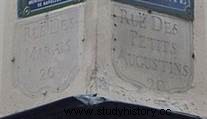 Nowadays it is simple to go to a defined address. We have the street name as well as the house number . All this was made compulsory by a decree of 1805. We thank the instigator of this decree, because there was a time, the journey was more epic to get to an individual. In the 17th century, to look for the young lady Louison in Paris, friend of the poet Berthaud, one could read her address as "residing at Alizon's, precisely on the fifth floor, near the cabaret de la Cage, in a room with two frames, near Saint- Pierre des Assises! Not really practical you will tell me...
Nowadays it is simple to go to a defined address. We have the street name as well as the house number . All this was made compulsory by a decree of 1805. We thank the instigator of this decree, because there was a time, the journey was more epic to get to an individual. In the 17th century, to look for the young lady Louison in Paris, friend of the poet Berthaud, one could read her address as "residing at Alizon's, precisely on the fifth floor, near the cabaret de la Cage, in a room with two frames, near Saint- Pierre des Assises! Not really practical you will tell me...
The first street signs
And yet, it was customary to name the streets by "the path that goes to Montmartre" or "the street that goes to the Seine" with regard to the number of the dwelling , the explanation was most comical, as shown by this example for the son of the doctor Belin "housed in rue de la Harpe, with a hatter, in Main Fleurie, the third bedroom opposite the Gibecière, very close to the Crossbow".
The streets, as we can see, had no particular name, but reference was made to the signs, or to the name of a well-known notable living in the street as the " rue des Célestins” or depending on the inhabitants and communities of people “rue des Bourguignons”, “rue de la Bretonnerie”.
 In 1728, the Paris police lieutenant had plaques placed on the first and last house on the street “We are working on numbering the streets of Paris on a tin plate that we apply to each street corner, and which also contains the names of the said streets”, to which we added a letter or a number corresponding to the district. A good part of the population was satisfied, but of course there were recalcitrants who preferred another street name:the plates were degraded or completely removed. The administration was on the watch and issued an ordinance in July 1729 stipulating that "in the event of the removal or wear of the plates, the owners would be required to replace them with tables of stone from Liais an inch and a half thick, of large enough to engrave the same names and the same numbers…”. This is how some weird street names disappeared, like the “cul-de-sac de…”.
In 1728, the Paris police lieutenant had plaques placed on the first and last house on the street “We are working on numbering the streets of Paris on a tin plate that we apply to each street corner, and which also contains the names of the said streets”, to which we added a letter or a number corresponding to the district. A good part of the population was satisfied, but of course there were recalcitrants who preferred another street name:the plates were degraded or completely removed. The administration was on the watch and issued an ordinance in July 1729 stipulating that "in the event of the removal or wear of the plates, the owners would be required to replace them with tables of stone from Liais an inch and a half thick, of large enough to engrave the same names and the same numbers…”. This is how some weird street names disappeared, like the “cul-de-sac de…”.
Streets were named, but house numbers? As we saw above, the signs served as an indication. We also mentioned "the house of the Grand Pignon" or "the Painted house" and very often, even if the house was transformed, the term remained in the memories and was used, but caused confusion, people not always finding the address.
And yet, did you know that there were already numbers at the dwellings in the years 1415? Indeed, private houses were built on the Pont Notre Dame and an agreement of November 1436 established the numbering to the right and to the left of the dwelling, the address then mentioning the number, the side of the bridge and the position downstream or upstream. But the bridge threatened to fall into ruin in 1440, the reconstruction was done in 1512 with thirty four houses on both sides. Numbers were assigned “above the door of each of them was placed, in golden letters and on a red or blue background, a large number formed of Roman numerals. The numbers, instead of following each other, were divided into 2 series, the even numbers on one side and the odd numbers on the other”.
Street numbering, frowned upon by the population
 It was not until 1726 that the municipality decreed the numbering of carriage and cart gates, under the control of the treasurer of France, produced by the officers of the finance office of the generality of Paris, but the Parisians were recalcitrant, they understood by this, not a practice which was going to make their life easier, but an intention to increase the taxes. Attempts were made to repeat the operation in 1740 and 1765, without much success. The Royal Almanac mentions between 1760 and 1775, various numbered houses but belonging to a police inspector and four or five councilors in Parliament, people submitting to the request of the municipality and trying to set a good example.
It was not until 1726 that the municipality decreed the numbering of carriage and cart gates, under the control of the treasurer of France, produced by the officers of the finance office of the generality of Paris, but the Parisians were recalcitrant, they understood by this, not a practice which was going to make their life easier, but an intention to increase the taxes. Attempts were made to repeat the operation in 1740 and 1765, without much success. The Royal Almanac mentions between 1760 and 1775, various numbered houses but belonging to a police inspector and four or five councilors in Parliament, people submitting to the request of the municipality and trying to set a good example.
The other addresses remained as before "Papillon, wood engraver, in Paris, rue de Bièvre, near Place Maubert, after the first carriage entrance on the right, in the long driveway, on the second floor of the grand staircase. 1769”! Some attempts at numbering were undertaken, but generally this put off the nobility as well as the merchants. The great lords, the rich financiers did not always have exemplary neighbors and did not appreciate seeing their address and the numbering with a furnished hotel or a shop as a neighbor.
At the time of the Revolution, the Parisian had other concerns than numbering his home...
Legislation imposes numbers and plates
Finally, a decree of February 1805 made it compulsory to number houses "a series of numbers for the same street, a single number placed on the main door of the dwelling, the even numbers for the right side of the street, odd numbers for the left side, knowing that the right side of a street will be determined, in the perpendicular or oblique streets along the Seine, by the right of the passer-by heading towards the river, and in those parallel, by the right of the passerby walking in the direction of the course of the river”.
The municipality of Paris takes care of the numbering, but the maintenance is up to the owners who can change the plate if they do not like them while respecting the specifications:height, location, color. The numbering was in black on an ocher background for the streets perpendicular and oblique to the Seine, and red on the same background for the parallel streets. This numbering was extended to the cities of the departments in April 1823. It was not until 1847 that Rambuteau ordered plates as we know them today:numbers and letters in white on a blue background.
Sources
Revue France Pittoresque 2nd quarter 2008 excerpts from:
- Political and Literary Review of 1879
- Bulletin of the Society for the History of Paris and Ile de France in 1888
- The private life of the past - Parisian varieties published in 1901
